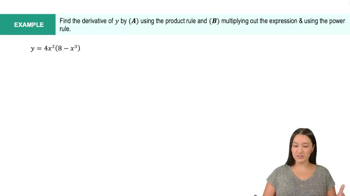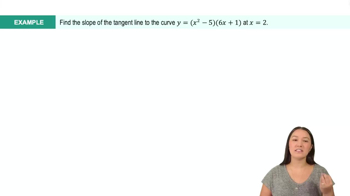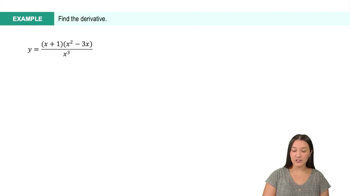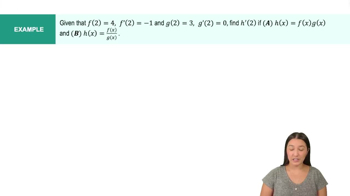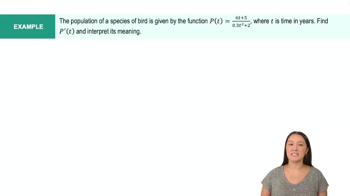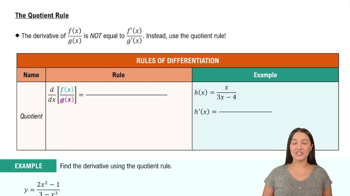Table of contents
- 0. Functions7h 52m
- Introduction to Functions16m
- Piecewise Functions10m
- Properties of Functions9m
- Common Functions1h 8m
- Transformations5m
- Combining Functions27m
- Exponent rules32m
- Exponential Functions28m
- Logarithmic Functions24m
- Properties of Logarithms34m
- Exponential & Logarithmic Equations35m
- Introduction to Trigonometric Functions38m
- Graphs of Trigonometric Functions44m
- Trigonometric Identities47m
- Inverse Trigonometric Functions48m
- 1. Limits and Continuity2h 2m
- 2. Intro to Derivatives1h 33m
- 3. Techniques of Differentiation3h 18m
- 4. Applications of Derivatives2h 38m
- 5. Graphical Applications of Derivatives6h 2m
- 6. Derivatives of Inverse, Exponential, & Logarithmic Functions2h 37m
- 7. Antiderivatives & Indefinite Integrals1h 26m
- 8. Definite Integrals4h 44m
- 9. Graphical Applications of Integrals2h 27m
- 10. Physics Applications of Integrals 2h 22m
3. Techniques of Differentiation
Product and Quotient Rules
Problem 3.85c
Textbook Question
Finding derivatives from a table Find the values of the following derivatives using the table. <IMAGE>
c. d/dx ((f(x)g(x)) |x=3
 Verified step by step guidance
Verified step by step guidance1
Step 1: Recall the product rule for derivatives, which states that if you have two functions f(x) and g(x), the derivative of their product is given by (f(x)g(x))' = f'(x)g(x) + f(x)g'(x).
Step 2: Identify the values you need from the table. You will need f(3), g(3), f'(3), and g'(3) to apply the product rule at x = 3.
Step 3: Substitute the values from the table into the product rule formula. This means replacing f(x) with f(3), g(x) with g(3), f'(x) with f'(3), and g'(x) with g'(3).
Step 4: Calculate each term separately. First, compute f'(3)g(3) and then f(3)g'(3).
Step 5: Add the results from Step 4 to find the derivative of the product at x = 3.
 Verified video answer for a similar problem:
Verified video answer for a similar problem:This video solution was recommended by our tutors as helpful for the problem above
Video duration:
3mPlay a video:
Was this helpful?
Key Concepts
Here are the essential concepts you must grasp in order to answer the question correctly.
Product Rule
The Product Rule is a fundamental differentiation rule used to find the derivative of the product of two functions. It states that if you have two functions, f(x) and g(x), the derivative of their product is given by d/dx(f(x)g(x)) = f'(x)g(x) + f(x)g'(x). This rule is essential for solving problems involving the multiplication of functions.
Recommended video:
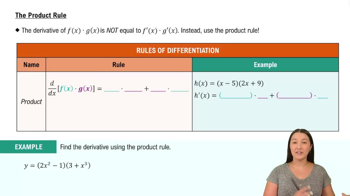
The Product Rule
Evaluating Derivatives at a Point
Evaluating derivatives at a specific point involves substituting the value of x into the derivative expression after it has been calculated. In this case, after applying the Product Rule, you will substitute x = 3 into the resulting expression to find the specific value of the derivative at that point. This step is crucial for obtaining numerical answers from derivative expressions.
Recommended video:

Critical Points
Using Derivative Tables
Derivative tables provide pre-calculated values of derivatives for various functions at specific points. When solving derivative problems, such as the one presented, these tables can be used to quickly find f'(3) and g'(3) without needing to compute the derivatives from scratch. This efficiency is particularly useful in problems where time or complexity is a factor.
Recommended video:

Derivatives
Related Videos
Related Practice



